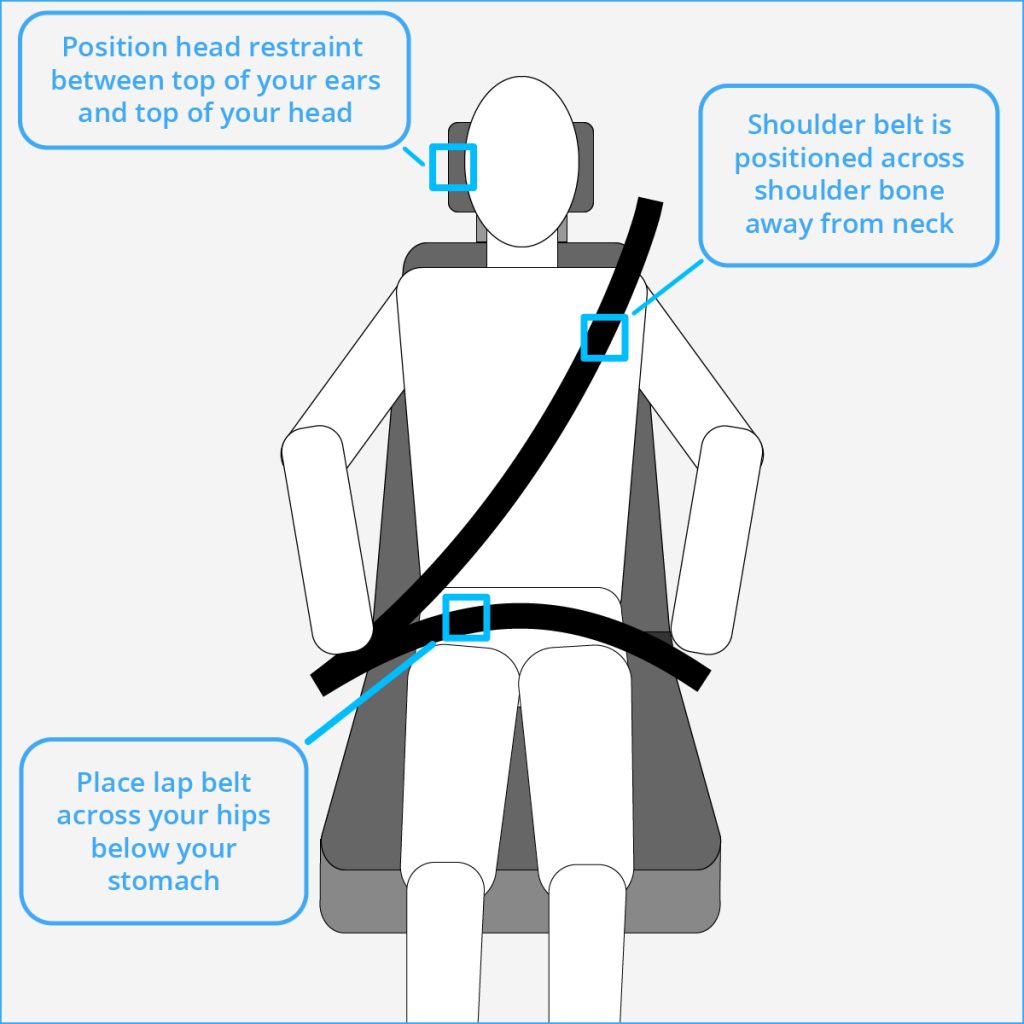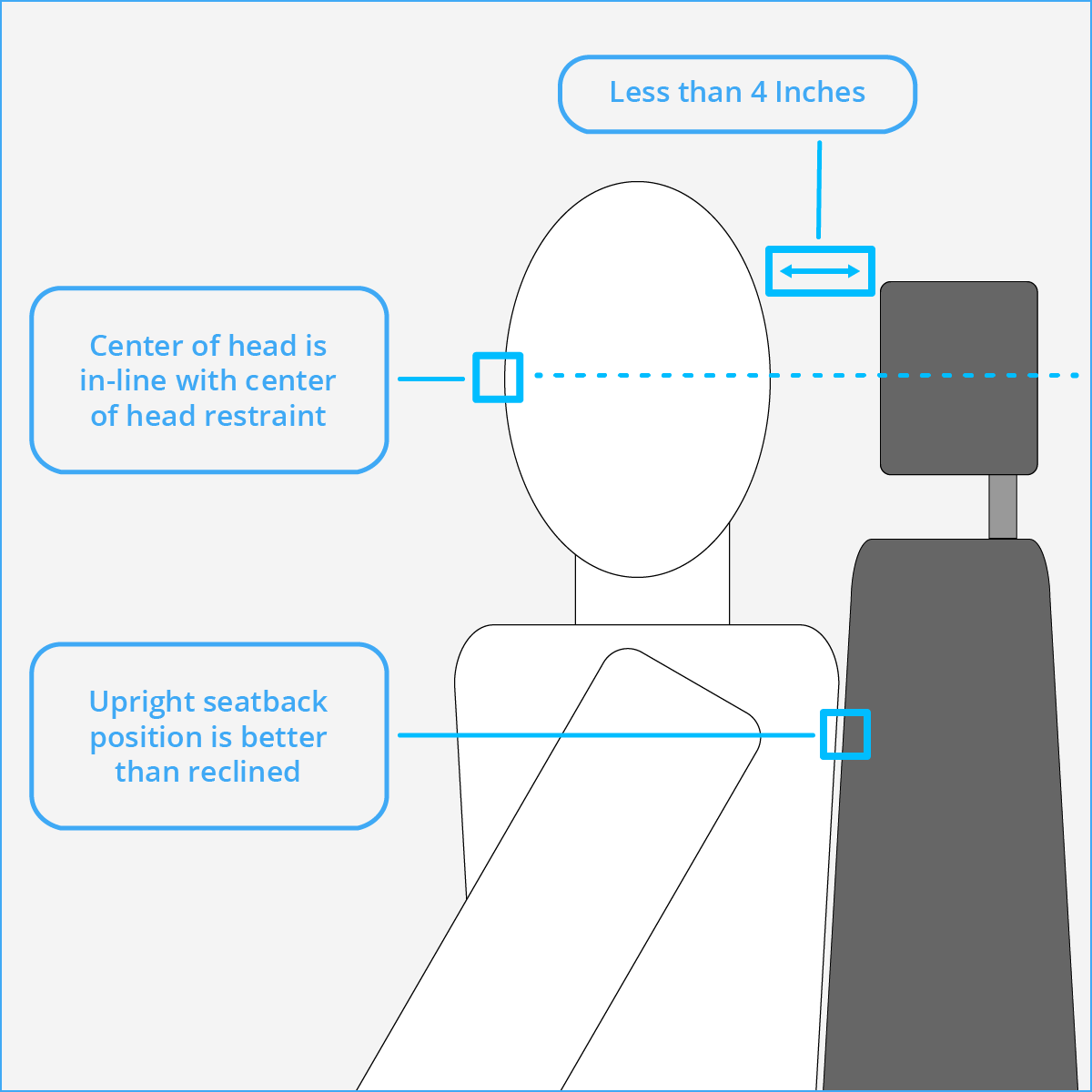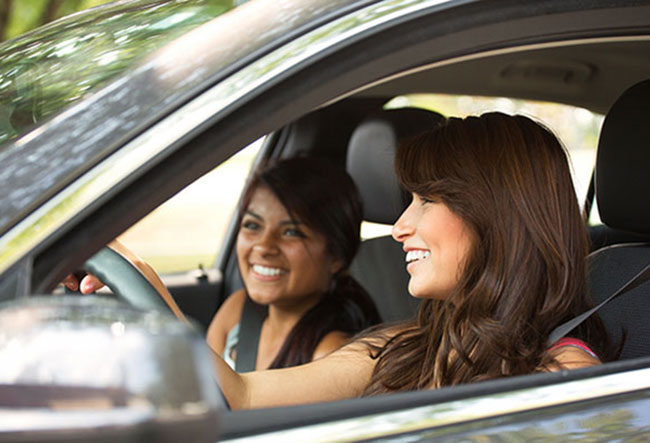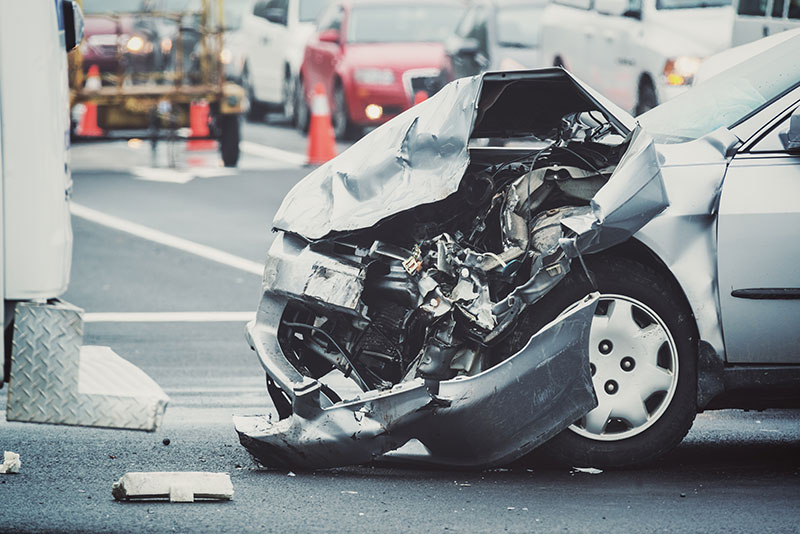Teens
Car crashes are a leading cause of death among teens. In fact, teens, as both driver and passengers have the lowest seat belt usage among any age group. Did you know two-thirds of teens killed in crashes were not wearing seat belts? In the event of a sudden stop or car crash, your seat belt is designed to keep YOU and EVERYONE else in the car in place. The fact is, if you are thrown from the vehicle you will not land on a pillow. You will likely land on asphalt, plummet into a pole, skid across pavement or get run over by another car. How do you prevent this from happening? It’s easy—click it!
For more information on teen driving safety, visit ZeroFatalities.com
The Top Five Things to Know about Buckling Up:
Buckling up is the single most effective thing you can do to protect yourself in a crash.
Seat belts save approximately 15,000 lives each year. While most people wear their seat belts, nearly half of people who die in crashes are not belted. (IIHS)
If you are completely thrown from a vehicle during a crash, it is almost always fatal. If you do survive, it’s gonna hurt. Buckling up keeps you safe and secure inside your vehicle and can save your life—and your face. Seat belts are the best defense against impaired, aggressive, drowsy and distracted drivers.

Know how to buckle up properly.
The lap belt and shoulder belt are secured across the hip bones, across the chest and positioned at mid shoulder; these bones are more equipped to withstand crash forces than other parts of your body. Wearing BOTH your lap and shoulder belt is the best line of defense.
- The head restraint should lie somewhere between the top of your ears and the top of your head.
- Place the shoulder belt across your shoulder bone, down the middle of your chest and away from your neck.
- Adjust the lap belt across your hips below your stomach.
NEVER put the shoulder belt behind your back or under your arm.
Airbags are designed to work with seat belts, not replace them.
Did you know that airbags open at a rate of 100-200 mph? If you are thrown directly into a rapidly opening airbag without any restraining help from your seat belt, the force could injure or even kill you. Seat belts are designed to work together with airbags—the seat belt secures the occupant and the airbag lessens the crash impact. Visit www.iihs.org for more information on airbag safety.
Tips:
- Always keep at least 10 inches between the center of your chest and the steering wheel cover or dashboard.
- Drivers and front passengers should sit in the center of the seat upright against the seatback with feet on the floor.
- Children under age 13 should ride properly restrained in the back seat, as the back seat is the safest for children. If you have an airbag ON-OFF switch, check its position every time you enter your vehicle.
- One survey shows that 48 percent of these ON-OFF switches were incorrectly left ON for child passengers under age 13. For information on airbag safety, visit the IIHS.org website.
- Passengers, including children shouldn’t lean against the vehicle door or window. With or without an airbag, passengers who lean against doors are at higher risk of injury in the event of a side impact crash.
Occupant protection is for everyone.

Click it, Utah. Every one, every trip.
Fit matters.
- Before you buy a new car, check to see that its seat belts are a good fit for you.
- If you’re short, ask your dealer about seat belt adjusters, which can help you get the best fit. Click here for more information.
- If you need a roomier belt, contact your vehicle manufacturer to obtain a seat belt extender. Click here for more information.
- If you drive an older or classic car with no seat belts or lap belts only, check with your vehicle manufacturer about how to update your car with today’s safer lap/shoulder belts.
Air Bag Information
As of 2015, National Highway Traffic Safety Administration (NHTSA) estimates that frontal airbags have saved 44,869. However, these are supplemental safety devices and motorists should always wear a seat belt. In addition, children under 13 should ride properly protected in the back seat, as the back seat is the safest for children. If you have an airbag ON-OFF switch, check its position every time you enter your vehicle. One survey shows that 48 percent of these ON-OFF switches were incorrectly left ON for child passengers under age 13. For information on airbag safety, visit the IIHS.org website.
For more information on how airbags work and the science and innovation behind them, visit the IIHS.org.
Facts
Air bags help seat belts save lives. Check out these facts:
- Front airbags reduce driver fatalities in frontal crashes by 29 percent and fatalities of front-seat passengers age 13 and older by 32 percent (Kahane, 2015)
- Side airbags that protect the head reduce a car driver’s risk of death in driver-side crashes by 37 percent and an SUV driver’s risk by 52 percent (McCartt & Kyrychenko, 2007).
Head Restraints
Like the seat belt, head restraints are a critical part of your vehicle’s safety equipment. Correct positioning of your head restraint can protect you and your passengers from whiplash injuries, a broken neck and death.
- To minimize neck injury, NHTSA suggests placing the head restraint at a height where the center of your head is in-line with the center of the head restraint.
- The distance from the back of the head to the restraint should be as small as possible, preferably less than four inches, according to the Insurance Institute of Highway Safety.
If the head restraint can be horizontally adjusted, it should be placed so that it’s as close to your head as possible, without pushing your head forward or causing the height of the restraint to drop. - The position of your seatback is also important—less is better when it comes to reclining. A more upright seatback means that the head restraint will likely be in a safer position—one that’s closer to your head.

Frequently Asked Questions
By not using the seat belt properly you can face the risk of serious injury or death. Correct placement is against the strong bones of the body—the shoulder bone and the hip bones.
The lap belt should sit two to four inches below the waist, against the hips and upper thighs. It should never sit high over the ribs and stomach because it can slice through those soft bones and tissue. If you’re short and the lap belt is fitting too high, try raising the seat (some cars have automatic or manual adjusters, typically near the bottom of the seat—see owner’s manual for instructions specific to your vehicle).
The shoulder belt should be worn snugly across the chest with the belt lying against the mid-shoulder. It should never be worn under the arm or behind the back; doing so can result in spinal injury, punctured lungs, broken ribs and/or death.
If there is a problem with proper belt fit, one way to help the shoulder belt fit better is to move closer to where the belt buckles (e.g., on the driver’s side, move toward the right). Newer cars also have a seat belt adjuster on the side of the car, where the shoulder belt begins. The adjuster lessens the angle at which the belt crosses the neck, and helps ensure proper fit in many vehicles.
Note: When a seat is too-far reclined, the shoulder belt is no longer touching the shoulder bone and the seat belt can’t do its job correctly. Though it may be tempting as a passenger to recline the seat back or even sprawl vertically in the back seat and catch some zzzz’s, no nap is worth the price of your life or your health. Play around with ways to nap comfortably with the seat upright and the belt properly placed. Be aware of airbag deployment zones. With or without an airbag, passengers who lean against doors or lie down with their heads near the doors or sides of vehicles are at higher risk of injury in the event of a side impact.
Yes. The maximum fine is $45. A driver can be cited for each passenger that is not buckled up, but each person over the age of 16 years old not wearing their seat belt will be given their own ticket.
In a crash, your body weight is multiplied by the speed of the car. For example, if you weigh 130 pounds and crash while traveling 65 mph, your body would hit with a force of 8,450 pounds. There is no way you can brace yourself against that much force and your chances of being thrown from the car are much higher if you aren’t restrained in a seat belt.
No. Seat belts are designed to fit adults and can be a danger to young children. By law, children are required to ride in an appropriate child safety seat or booster seat until they are eight years old, unless they are 4’9″ or taller. As the driver, it is your responsibility to make sure children are put in a car seat or booster seat properly. Click here for guidance on child passenger safety.
Air bags, safety belts and child restraints are generally considered “one-time use” products. After a crash they may need to be replaced. Without a doubt, airbags and pretensioners (a device some seat belt systems use for added safety) must be replaced if they are activated during a crash. Vehicle manufacturers also recommend that safety belts activated in a crash be replaced, except in minor crashes. A smart idea is to have your belt inspected by a service technician after any type of collision. For more information, contact the manufacturer of your vehicle. Seriously, though—call.
The seat belt is designed to contact the strongest points of the body—the pelvis and the collarbone. When it is not worn properly, the user risks soft tissue damage to vital organs like the lungs, stomach, liver and even spinal cord—all of which can be quite painful and debilitating. Another risk of wearing the seat belt improperly is flying out of the vehicle because the seat belt can no longer restrain, causing injuries, deformities and often death.
- The first collision is the car crash.
- The second collision is the human collision. A person not wearing their seat belt in a crash will fly forward and hit elements inside of the vehicle, such as the steering wheel, window or other object in the path of motion.
- The third collision is the internal collision. This is where it can get ugly if you are not wearing a seat belt. In the internal collision, the occupant’s internal organs move toward the point of impact and hit other organs, bones and the skull. Even though the person may appear uninjured, the liver, spleen, heart, or other organs may be torn, bruised and/or caused to bleed. Severe damage to the brain could also occur. Watch this.
This is a very dangerous idea as the two people can collide repeatedly at high forces in a crash or be ejected because the seat belt can no longer restrain. Each seat belt is designed for one individual. If there are not enough seat belts for the amount of people wanting to ride in the car, find another means of transportation that will allow each person to have their own seat belt. Share your ice cream sundae, not your seat belt.
Air bags are designed to work in conjunction with a properly used lap and shoulder belt. The belt secures you in your seat and the airbag softens the impact. Without a seat belt, the airbag is going to collide with you as it deploys at least 100 mph. Ouch.
When driving, sit up straight at least 10 inches away from the steering wheel for added airbag protection in the event of a crash.
Myths vs. Facts
MYTH:
I’m strong and I could brace myself if a crash occurred.
FACT: At 35 mph, the force of impact on you and your passengers is brutal. There is no way that your arms and legs can brace yourself against that kind of collision; the speed and force are just too great. Try this math test: if you weighed 100 pounds and were going 35 mph (not very fast, right?) and crashed without a seat belt, how many pounds of pressure would it take for you to hold yourself back? Your weight (100 pounds) times the speed of the car (35 mph) = 3,500 pounds. That is the amount of pressure it would take to hold you back in a crash. That is the size of a hippopotamus. Can you lift a hippo? I think not, wise guy!
MYTH:
If I wear a seat belt, I might be trapped in a burning or submerged car!
FACT: Less than one-half of one percent of all injury-producing collisions involves fire or submersion. Even if fire or submersion does occur, wearing a seat belt can protect you from the crash impact and save your life.
If you’re involved in a crash without your seat belt, you might be knocked unconscious by striking the interior of the car or sustain critical injuries from being ejected. Then your chances of getting out of a burning or submerged car would be far less.
By wearing your seat belt properly you are more likely to be alert and capable of escaping quickly with less injuries.
MYTH:
I’m not going far and I won’t be going fast.
FACT: Most crash fatalities occur within 25 miles of home and at speeds of less than 40 mph. This emphasizes that everyday driving to your friend’s house, to school or to the store poses the greatest danger. Does this mean you’re off the hook when driving on a road trip to Disneyland? Uh…no. Click it, everywhere, every time.

MYTH:
I might be better off if I’m thrown clear from the car in a crash.
FACT: Your chances of being killed in a crash are 23 times greater if you are thrown from the car. The forces in a collision can be great enough to fling you as much as 150 feet—about 15 car lengths.
Seat belts can keep you from:
- Plunging through the windshield.
- Being thrown out the window and hurtled through the air.
- Landing on asphalt, a tree or a pole.
- Scraping along the ground or a fence.
- Being crushed by your own car.
- Getting run over by other cars.
In almost any collision, you’re better off being held inside the car by seat belts.

MYTH:
Seat belts can hurt you in a crash.
FACT: Properly worn seat belts seldom cause injuries. If they do, the injuries are usually surface bruises and are most often less severe than if you weren’t wearing a seat belt. Without the seat belts, you could have likely been thrown out of the vehicle and been injured severely or killed. In fatal crashes in 2017, about 83 percent of passenger vehicle occupants who were totally ejected from the vehicle were killed. (IIHS) Studies have consistently shown that injuries in most serious crashes would have been much more severe had seat belts not been worn. Sure, if you stick the seat belt behind your back or under your arm, it can do damage. So wear it correctly! Bottom line, seat belts save lives when worn properly.
MYTH:
I’m a good driver, it won’t happen to me.
FACT: You may be a good driver but you cannot always control the other drivers on the road. The statistics related to motor vehicle crashes and irresponsible drivers are devastating. Even if you are driving defensively, an impaired or distracted driver coming around the next curve may not be. It’s tragic to think that someone died because they chose not to buckle up. A simple decision could mean life or death.You never know what might happen. Play it safe and buckle up every time.
MYTH:
Wearing a seat belt is a personal decision that doesn’t affect anyone else.
FACT: In the situation of a crash, an unbuckled occupant becomes a deadly projectile around. How dangerous? Imagine getting hit by a 100 lb person at 60 mph. That’s a 600 pound headbutt! Plus, not wearing a seat belt can certainly affect your family and friends whose lives would never be the same if you were killed, brain damaged or injured in a crash.

FACTS:
- Teenagers are especially at risk of being in a motor vehicle crash. In 2018 alone, teen drivers were involved in 13,071 crashes where there were 17 fatalities.
- Teenage drivers represented 8 percent of the licensed drivers in Utah, yet they were in 20 percent of all motor vehicle crashes.
- Inexperience behind the wheel is the number one reason teen drivers get into crashes.
- Teens are also more likely than adults to make critical decision errors that lead to serious crashes. (CDC)
- Teenage drivers in Utah were 1.7 times more likely to be in a crash than drivers of other ages.
- Parents who set rules and monitor their teen’s driving behavior in a supportive way can cut their teen’s crash risk in half. (Children’s Hospital of Philadelphia)
- 80 percent of Utah teen drivers and their passengers killed in crashes were unrestrained.
- Among young drivers aged 15-20 who died in car crashes in 2017, almost half were unrestrained at the time of the crash (when restraint use was known). (CDC)
- Compared with other age groups, teens have the lowest rate of seat belt use.
- Among teen drivers, those at especially high risk for motor vehicle crashes are:
- Males: In 2017, the motor vehicle death rate for male drivers and passengers ages 16 to 19 was over two times that of their female counterparts.
- Teens driving with teen passengers: The presence of teen passengers increases the crash risk of unsupervised teen drivers. This risk increases with the number of teen passengers.
- Newly licensed teens: Crash risk is particularly high during the first months of licensure. (CDC)
